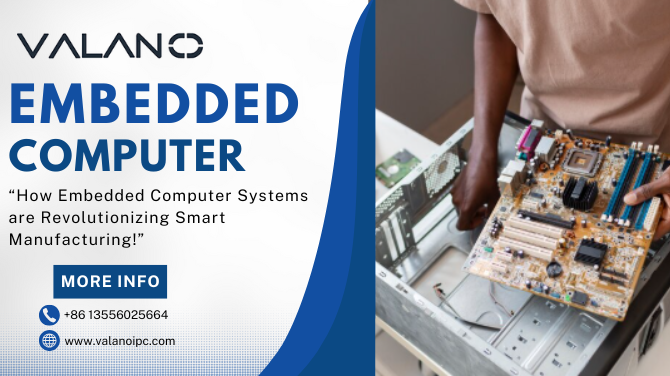Notifications

9 minutes, 30 seconds
-18 Views 0 Comments 0 Likes 0 Reviews

In today's rapidly evolving industrial landscape, embedded computer systems have emerged as the cornerstone of smart manufacturing. As we witness the dawn of Industry 4.0, these sophisticated technological solutions are fundamentally transforming how factories operate, how products are manufactured, and how businesses compete in the global marketplace. At ValanoIPC, we've been at the forefront of this industrial revolution, providing cutting-edge embedded computer solutions that are reshaping the manufacturing sector.
First and foremost, let's understand why embedded computer systems have become indispensable in modern manufacturing. These purpose-built machines are designed to perform specific tasks with unparalleled efficiency, reliability, and precision. Unlike general-purpose computers, embedded computer systems are optimized for industrial applications, offering robust performance in challenging environments while maintaining minimal downtime.
An embedded computer, also known as an embedded system, represents a specialized computing platform designed to perform dedicated functions within a larger mechanical or electrical system. Unlike general-purpose computers, these sophisticated devices are engineered with specific industrial applications in mind, featuring robust hardware components and optimized software configurations that ensure reliable operation in challenging environments. Modern embedded computers integrate advanced processors, specialized I/O interfaces, and industrial-grade components that can withstand extreme temperatures, vibrations, and electromagnetic interference. These systems serve as the backbone of industrial automation, powering everything from manufacturing equipment and process control systems to medical devices and transportation infrastructure. What sets embedded computers apart is their ability to operate continuously with minimal maintenance, their enhanced security features that protect against cyber threats, and their remarkable longevity, often functioning reliably for a decade or more. In today's Industry 4.0 landscape, embedded computers have evolved to incorporate advanced capabilities such as real-time processing, edge computing, and seamless integration with IoT devices, making them indispensable tools for businesses seeking to modernize their operations and maintain a competitive edge in the global market.
The integration of embedded computer systems into manufacturing processes has yielded remarkable results across various sectors. For instance, automotive manufacturers have witnessed a 40% increase in production efficiency after implementing these systems. Similarly, pharmaceutical companies have reported a significant reduction in error rates, dropping from 2% to 0.001% when utilizing embedded computer solutions for quality control.
At ValanoIPC, we understand that the success of smart manufacturing relies heavily on the quality and reliability of embedded computer systems. Our solutions are engineered to meet the most demanding industrial requirements, featuring:
Industry Applications and Success Stories
The versatility of embedded computer systems has led to their adoption across various industries:
Automotive Manufacturing: A leading automotive manufacturer implemented ValanoIPC's embedded computer solutions across their production line, resulting in:
Food and Beverage Processing: A major beverage producer integrated our embedded computer systems, achieving:
Pharmaceutical Manufacturing: A pharmaceutical company utilized our solutions to:
The future of embedded computer systems in smart manufacturing looks even more promising. Several emerging trends are shaping the industry:
Best Practices for Implementation
To maximize the benefits of embedded computer systems, manufacturers should consider the following best practices:
Phased Implementation
Regular Maintenance and Updates
The integration of embedded computer systems in smart manufacturing represents a significant leap forward in industrial automation and efficiency. As technology continues to evolve, these systems will become even more sophisticated, offering enhanced capabilities and improved performance. At ValanoIPC, we remain committed to developing innovative solutions that help manufacturers stay competitive in an increasingly digital world.
The future of manufacturing lies in the successful implementation of these advanced systems, and companies that embrace this technology today will be better positioned to succeed tomorrow. Through careful planning, proper implementation, and ongoing support, manufacturers can leverage embedded computer systems to achieve unprecedented levels of efficiency, quality, and productivity.
Q: What makes embedded computer systems different from regular computers?
A: Embedded computer systems are purpose-built for specific industrial applications, offering enhanced durability, reliability, and performance in harsh environments. They are designed for continuous operation and feature specialized components for industrial use.
Q: How long do embedded computer systems typically last?
A: With proper maintenance, industrial embedded computer systems can last 7-10 years or more, depending on the operating environment and usage patterns.
Q: What are the key factors to consider when choosing an embedded computer system?
A: Important factors include:
-Processing requirements
-Environmental conditions
-Connectivity needs
-Future scalability
-Maintenance requirements
-Total cost of ownership
Q: How do embedded computer systems contribute to energy efficiency?
A: These systems are designed for optimal power consumption and can help reduce energy usage through:
-Efficient process control
-Smart power management
-Optimized resource utilization
-Reduced waste production
Q: What kind of ROI can companies expect from implementing embedded computer systems?
A: While ROI varies by industry and application, many companies report:
-20-40% reduction in operational costs
-30-50% improvement in productivity
-25-35% decrease in maintenance expenses
-12-18 month payback period

